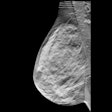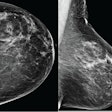
Not all women are getting the information they need about their breast tissue density and the availability of supplemental screening, despite the fact that almost half of U.S. states have passed legislation that mandates women be informed. Hispanic/Latina women in particular aren't getting the message.
That's according to research presented recently at the San Antonio Breast Cancer Symposium (SABCS). It's possible that Hispanic/Latina women are less informed due in part to communication issues, said presenter Beth Jones, PhD, from Yale University and Yale Cancer Center. Jones and colleagues found that even though Connecticut's breast density notification law was enacted in 2009, Hispanic/Latina women have not been receiving supplemental screening.
 Beth Jones, PhD, from Yale University.
Beth Jones, PhD, from Yale University."In this largely foreign-born, English-second-language population, effective communication regarding breast cancer risk, breast density, and the availability of follow-up ultrasound or other testing represents a significant cancer care challenge," Jones said.
What do they know?
Jones' group began a prospective study of mammography screening among Hispanic/Latina women after the Connecticut law was enacted. The team enrolled 668 women who presented at primary healthcare settings in the four Connecticut cities with the largest Latino populations: Bridgeport, Hartford, New Haven, and Waterbury. Women eligible for the study were between the ages of 40 and 75, self-identified as Hispanic/Latina, and had a negative history for breast cancer or breast biopsy.
Eighty-four percent of the women included in the study were born in Puerto Rico or outside of the U.S. More than half (51%) had household incomes of less than $10,000 per year, and 54% had less than a high school education. Only 14% reported that they could speak English "very well." Sixty-five percent had received a mammogram in the previous year; 21.4% met criteria for receiving ultrasound due to heterogeneously dense tissue (19.2%) or extremely dense tissue (2.3%) on screening mammography.
Of the total number of women included in the study, 634 had undergone a previous mammogram, but only 9% of these women had ever heard about breast tissue density as a cancer risk factor or knew their own density. Of the 142 women eligible for follow-up ultrasound, only 21 received it, according to Jones.
"The women's knowledge about breast density at our baseline interviews was pretty low to begin with," she told AuntMinnie.com.
One of the study's limitations is the small cohort of women who received supplemental testing, Jones said.
"At the time this study was funded, we had a larger cohort of 1,600 women, but we only had clinical information for 668," she said. "We'll have more data going forward and will be able to say more about why some women received supplemental testing and others did not."
Continuity of care
What's the best way to address the problem of this particular population of women not getting the supplemental imaging they need? Certainly making Spanish-speaking staff available is a good place to start, as well as sending notification letters in Spanish, Jones said. But it turns out that continuity of care may be a key factor as well.
"Even though we found these women in a setting where they were receiving care, a fair number reported not having a regular primary care physician," she told AuntMinnie.com. "We've seen in the literature that having the same provider over time is linked to screening adherence."
In any case, the results suggest that it's important to track just how changes to the healthcare delivery system affect particular populations.
"When we pass new healthcare laws, we need to pay attention to whether all groups benefit," she said. "Uptake of improvements in cancer screening may not occur at the same level or pace among different populations, inadvertently increasing disparities in cancer outcomes."




















